文学文体翻译
- 格式:ppt
- 大小:899.00 KB
- 文档页数:60
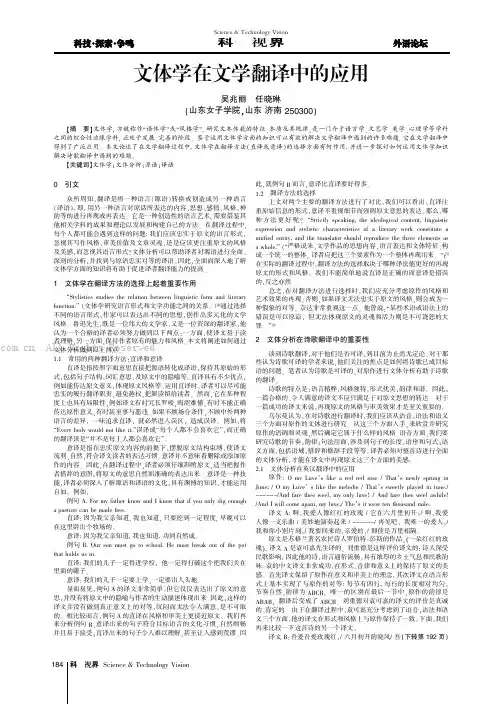
0引文众所周知,翻译是将一种语言(源语)转换或创造成另一种语言(译语),即,用另一种语言对原话所表达的内容、思想、感情、风格、神韵等的进行再现或再表达。
它是一种创造性的语言艺术,需要借鉴其他相关学科的成果和理论以发展和构建自己的方法。
在翻译过程中,每个人都可能会遇到这样的问题:我们应该忠实于原文的语言形式,忽视其写作风格、审美价值及文章灵魂,还是应该更注重原文的风格及美感,而忽视其语言形式?文体分析可以帮助译者对源语进行全面、深刻的分析,并找到与原语忠实对等的译语。
因此,全面而深入地了解文体学方面的知识将有助于促进译者翻译能力的提高。
1文体学在翻译方法的选择上起着重要作用“Stylistics studies the relation between linguistic form and literary function.”(文体学研究语言形式和文学功能之间的关系。
)[1]通过选择不同的语言形式,作家可以表达出不同的思想,创作出多元化的文学风格。
鲁迅先生,既是一位伟大的文学家,又是一位资深的翻译家,他认为一个合格的译者必须努力做到以下两点:一方面,使译文易于读者理解,另一方面,保持作者原有的魅力和风格。
本文将阐述如何通过文体分析做到以上两点。
1.1常用的两种翻译方法:直译和意译直译是指按照字面意思直接把源语转化成译语,保持其原始的形式,包括句子结构,词汇意思,及原文中的隐喻等。
直译具有不少优点,例如能传达原文意义,体现原文风格等。
运用直译时,译者可以尽可能忠实的履行翻译职责,避免越权,把解读留给读者。
然而,它在某种程度上也具有局限性,例如译文有时冗长罗唆,晦涩难懂,有时不能正确传达原作意义,有时甚至事与愿违。
如果不顾场合条件,不顾中外两种语言的差异,一味追求直译,就必然进入误区,造成误译。
例如,将“Every body would not like it.”误译成“每个人都不会喜欢它”,而正确的翻译该是“并不是每上人都会喜欢它”。

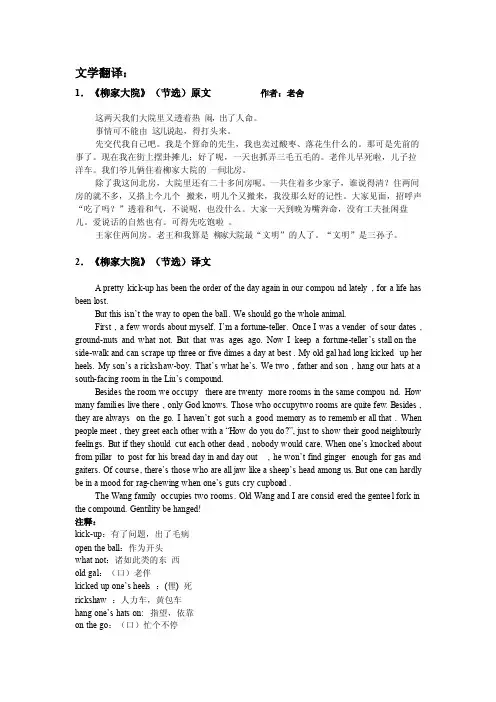
文学翻译:1.《柳家大院》(节选)原文作者:老舍这两天我们大院里又透着热闹,出了人命。
事情可不能由这儿说起,得打头来。
先交代我自己吧。
我是个算命的先生,我也卖过酸枣、落花生什么的。
那可是先前的事了。
现在我在街上摆卦摊儿;好了呢,一天也抓弄三毛五毛的。
老伴儿早死啦,儿子拉洋车。
我们爷儿俩住着柳家大院的一间北房。
除了我这间北房,大院里还有二十多间房呢。
一共住着多少家子,谁说得清?住两间房的就不多,又搭上今儿个搬来,明儿个又搬来,我没那么好的记性。
大家见面,招呼声“吃了吗?”透着和气,不说呢,也没什么。
大家一天到晚为嘴奔命,没有工夫扯闲盘儿。
爱说话的自然也有。
可得先吃饱啦。
王家住两间房。
老王和我算是柳家大院最“文明”的人了。
“文明”是三孙子。
2.《柳家大院》(节选)译文A prettykick-up has been the order of the day again in our compoun d lately, for a life has been lost.Butthisisn’tthewaytoopentheball. We shouldgo the whole animal.First , a few words about myself.I’mafortune-teller. Once I was a venderof sour dates , ground-nuts and what not. But that was ages ago. Now I keep a fortune-teller’sstallontheside-walk and can scrapeup three or five dimes a day at best. My old gal had long kickedup her heels. Myson’saricksha w-boy. That’swhathe’s. We two , fatherand son , hang our hats at a south-facingroom in the Liu’scompoun d.Besides the room we occupythere are twentymore rooms in the same compoun d. How many familie s live there , only God knows. Those who occupytwo rooms are quite few. Besides , they are alwaysonthego.Ihaven’tgotsuchagoodmemor yas to remembe r all that. When peoplemeet , theygreeteachotherwitha“Howdoyoudo?”, just to show their good neighbo urly feeling s. But if they shouldcut each other dead , nobodywould care. Whenone’sknocked about from pillarto post for his bread day in and day out , hewon’tfindgingerenoughfor gas and gaiters. Of course, there’sthosewhoarealljawlikeasheep’sheadamongus. But one can hardlybe in a mood for rag-chewingwhenone’sgutscrycupboar d .The Wang familyoccupie s two rooms. Old Wang and I are conside red the genteel fork in the compoun d. Gentili ty be hanged!注释:kick-up:有了问题,出了毛病open the ball:作为开头what not:诸如此类的东西old gal:(口)老伴kickedupone’sheels:(俚) 死ricksha w :人力车,黄包车hangone’shatson:指望,依靠on the go:(口)忙个不停cut sb. dead:不理睬某人knock about :(口)漂泊,游荡from pillarto post :四处奔走着,到处碰壁地,for his bread (俚) =for his moneyday in and day out :日复一日,每天不间断地ginger:(口)精力,活力,劲头gas :(俚)令人非常满意(或愉快的)的事(或人)bealljaw(likeasheep’shead):全是空话,废话连篇rag :(俚)姑娘,情人(指女性)guts:(用作单)贪食者be hanged:(用于诅咒语中)不得好死3.原文言语风格分析老舍先生是善于运用群众的言语大师。
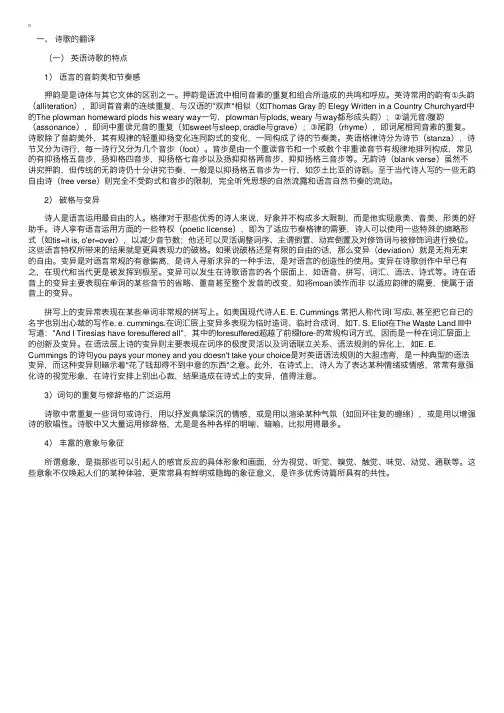
⼀、诗歌的翻译 (⼀)英语诗歌的特点 1)语⾔的⾳韵美和节奏感 押韵是是诗体与其它⽂体的区别之⼀。
押韵是语流中相同⾳素的重复和组合所造成的共鸣和呼应。
英诗常⽤的韵有①头韵(alliteration),即词⾸⾳素的连续重复,与汉语的"双声"相似(如Thomas Gray 的 Elegy Written in a Country Churchyard中的The plowman homeward plods his weary way⼀句,plowman与plods, weary 与way都形成头韵);②谐元⾳/腹韵(assonance),即词中重读元⾳的重复(如sweet与sleep, cradle与grave);③尾韵(rhyme),即词尾相同⾳素的重复。
诗歌除了⾳韵美外,其有规律的轻重抑扬变化连同韵式的变化,⼀同构成了诗的节奏美。
英语格律诗分为诗节(stanza),诗节⼜分为诗⾏,每⼀诗⾏⼜分为⼏个⾳步(foot)。
⾳步是由⼀个重读⾳节和⼀个或数个⾮重读⾳节有规律地排列构成,常见的有抑扬格五⾳步,扬抑格四⾳步,抑扬格七⾳步以及扬抑抑格两⾳步、抑抑扬格三⾳步等。
⽆韵诗(blank verse)虽然不讲究押韵,但传统的⽆韵诗仍⼗分讲究节奏,⼀般是以抑扬格五⾳步为⼀⾏,如莎⼟⽐亚的诗剧。
⾄于当代诗⼈写的⼀些⽆韵⾃由诗(free verse)则完全不受韵式和⾳步的限制,完全听凭思想的⾃然流露和语⾔⾃然节奏的流动。
2)破格与变异 诗⼈是语⾔运⽤最⾃由的⼈。
格律对于那些优秀的诗⼈来说,好象并不构成多⼤限制,⽽是他实现意美、⾳美、形美的好助⼿。
诗⼈享有语⾔运⽤⽅⾯的⼀些特权(poetic license),即为了适应节奏格律的需要,诗⼈可以使⽤⼀些特殊的缩略形式(如tis=it is, o'er=over),以减少⾳节数;他还可以灵活调整词序、主谓倒置、动宾倒置及对修饰词与被修饰词进⾏换位。
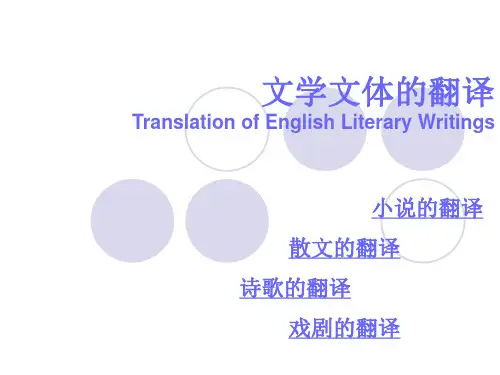

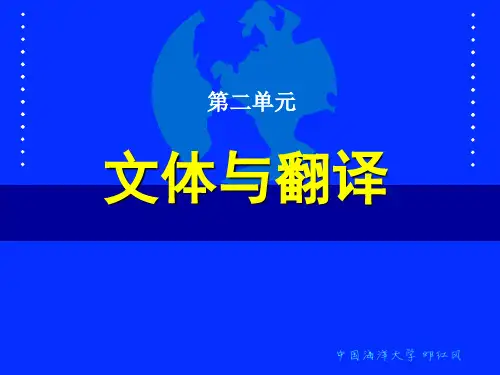
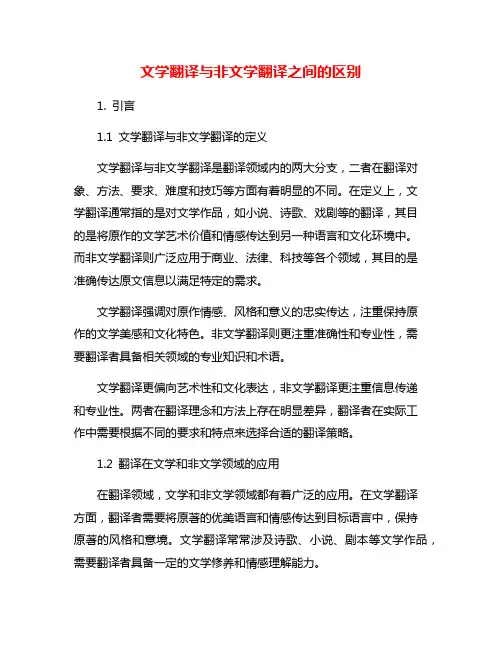
文学翻译与非文学翻译之间的区别1. 引言1.1 文学翻译与非文学翻译的定义文学翻译与非文学翻译是翻译领域内的两大分支,二者在翻译对象、方法、要求、难度和技巧等方面有着明显的不同。
在定义上,文学翻译通常指的是对文学作品,如小说、诗歌、戏剧等的翻译,其目的是将原作的文学艺术价值和情感传达到另一种语言和文化环境中。
而非文学翻译则广泛应用于商业、法律、科技等各个领域,其目的是准确传达原文信息以满足特定的需求。
文学翻译强调对原作情感、风格和意义的忠实传达,注重保持原作的文学美感和文化特色。
非文学翻译则更注重准确性和专业性,需要翻译者具备相关领域的专业知识和术语。
文学翻译更偏向艺术性和文化表达,非文学翻译更注重信息传递和专业性。
两者在翻译理念和方法上存在明显差异,翻译者在实际工作中需要根据不同的要求和特点来选择合适的翻译策略。
1.2 翻译在文学和非文学领域的应用在翻译领域,文学和非文学领域都有着广泛的应用。
在文学翻译方面,翻译者需要将原著的优美语言和情感传达到目标语言中,保持原著的风格和意境。
文学翻译常常涉及诗歌、小说、剧本等文学作品,需要翻译者具备一定的文学修养和情感理解能力。
而在非文学领域,翻译被广泛应用于商业、法律、科技、医学等各个领域。
非文学翻译更加注重对原文的准确性和专业性,翻译者需要具备相关领域的专业知识和术语词汇的熟练掌握。
非文学翻译的范围广泛,涉及到各种类型的文件、合同、报告等。
文学翻译和非文学翻译在应用领域上有明显的区别,要求翻译者具备不同的技能与素养。
文学翻译更注重对情感和文学意境的传达,而非文学翻译更注重对信息和专业性的准确传达。
翻译者需要根据不同领域的要求灵活运用不同的翻译技巧,以确保翻译的质量和效果。
2. 正文2.1 文学翻译与非文学翻译的翻译对象文学翻译和非文学翻译的翻译对象有着明显的区别。
文学翻译的翻译对象主要是文学作品,包括小说、诗歌、戏剧等。
这些作品具有一定的艺术性和文学性,翻译者需要在保持原作文学风格和情感表达的基础上,使目标语言读者能够感受到原作的美感和情感。
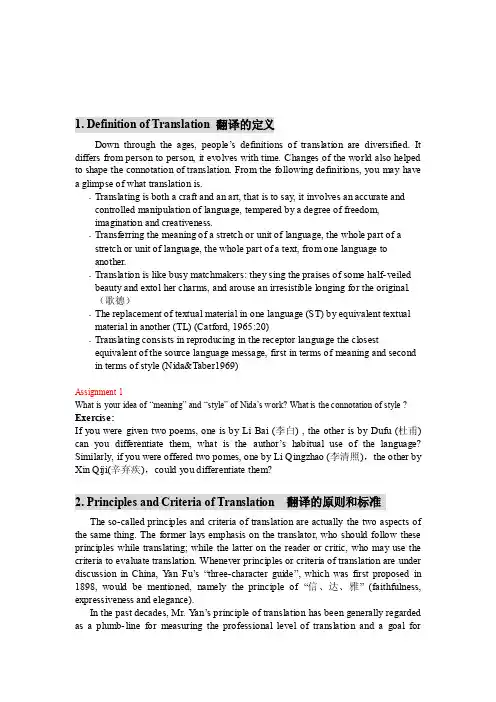
1. Definition of Translation 翻译的定义Down through the ages, people’s definitions of translation are diversified. It differs from person to person, it evolves with time. Changes of the world also helped to shape the connotation of translation. From the following definitions, you may have a glimpse of what translation is.﹒Translating is both a craft and an art, that is to say, it involves an accurate andcontrolled manipulation of language, tempered by a degree of freedom,imagination and creativeness.﹒Transferring the meaning of a stretch or unit of language, the whole part of astretch or unit of language, the whole part of a text, from one language toanother.﹒Translation is like busy matchmakers: they sing the praises of some half-veiled beauty and extol her charms, and arouse an irresistible longing for the original.(歌德)﹒The replacement of textual material in one language (ST) by equivalent textual material in another (TL) (Catford, 1965:20)﹒Translating consists in reproducing in the receptor language the closestequivalent of the source language message, first in terms of meaning and second in terms of style (Nida&Taber1969)Assignment 1What is your idea of “meaning” and “style” of Nida’s work? What is the connotation of style ? Exercise:If you were given two poems, one is by Li Bai (李白) , the other is by Dufu (杜甫) can you differentiate them, what is the author’s habitual use of the language? Similarly, if you were offered two pomes, one by Li Qingzhao (李清照),the other by Xin Qiji(辛弃疾),could you differentiate them?2. Principles and Criteria of Translation翻译的原则和标准The so-called principles and criteria of translation are actually the two aspects of the same thing. The former lays emphasis on the translator, who should follow these principles while translating; while the latter on the reader or critic, who may use the criteria to evaluate translation. Whenever principles or criteria of translation are under discussion in China, Y an Fu’s “three-character guide”, which was first proposed in 1898, would be mentioned, namely the principle of “信、达、雅”(faithfulness, expressiveness and elegance).In the past decades, Mr. Y an’s principle of translation has been generally regarded as a plumb-line for measuring the professional level of translation and a goal fortranslators to strive after. However, in the application of this principle, people have come to find some limitations to the three characters and put forward a variety of new standards instead.Three kinds of opinions are expressed on the principle of faithfulness, expressiveness and elegance. The first group maintains the original three characters, and in the meantime, adds some new concepts to the character “雅”. According to them, “雅”means far more than the English word “elegance”. Apart from the traditional interpretation, it also means classicism, and the adherence to the original style and flavor. The second group, however, argues that the word “雅” is out of place in tradition. While adopting the first two characters of Mr. Y an Fu’s principle, they discard the character “雅” and try to find some other new criteria instead. Noticeably, there are revisions such as “信、达、切” (faithfulness, expressiveness and closeness), “信、达、贴” (faithfulness, expressiveness and fitness), and so on. The third group of people, by casting away the three-word guide, proposes some new principles or criteria of translation of their own. Of the various popular theories, two of them are the most influential: spiritual conformity (神似) and sublimed adaptation (化境), the former, proposed by Fu Lei (傅雷) , emphasizes the reproduction of the spirit or the flavor of the original, while the latter, advocate by Qian Zhongshu (钱钟书), focuses on the translator’s smooth and idiomatic Chinese version for the sake of the Chinese reader.Despite the variety of opinions, two criteria are almost unanimously accepted, namely the criteria of faithfulness and accuracy (忠实准确) and that of smoothness (流畅). We may also take these tow criteria as the principles of translation in general. By faithfulness and accuracy, we mean to be faithful not only to the original contents, to the original meaning and views, but also to the original form and style. By smoothness, we mean not only easy and readable rendering, but also idiomatic expressions in the target language, free from stiff formula and mechanically copying from dictionaries.Assignment 2Exercise: 对比原文与译文,探讨忠实与通顺的关系1) All your moods are created by your thoughts o r “cognitions. “Y ou feel the way you do right now because of the thoughts you have at this moment. ”所有的情绪都是由思维产生的,或者说来源于“认识”,“你之所以感到这么做是对的,那是因为你的大脑就是这么想的。
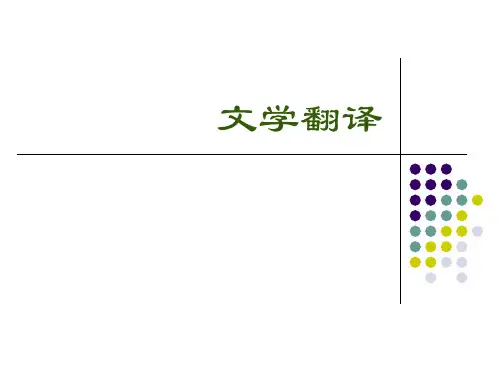
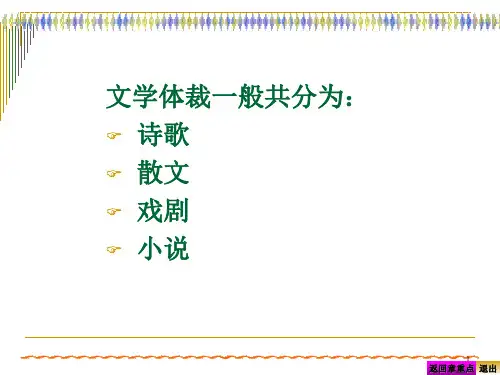
透析文学文体风格翻译社会符号学的语义观包括了风格要素,即原作的意义不仅存在于文本的语言本身,还存在于文本风格等方面。
根据不同标准对风格分类,常见的风格类型有语言的民族风格、时代风格、地域风格、流派风格、语体风格、文体风格、个人风格和表现风格。
在文学作品翻译中,保持原文风格是一项重要而艰巨的任务。
在文学翻译中,原风格的再现是研究作者或作品思想内容与语言文采的统一性及多样性的要求。
很大程度上原风格反映的是作者的价值取向、文采的表现规律和艺术感染力,有助于读者准确把握和分析作者的思想内涵及作品风格。
本文将从文体风格,时代风格,作家个人风格和民族风格几个角度对文学文体的风格翻译进行论述。
一、适应原文的文体风格文体风格是指因文体差异而产生的语言运用特点的综合。
翻译必须密切适应原文的文体风格,译文中遣词造句必须符合文体的需要。
不同的文章,在语言的运用中也有风格上的区别,如有的直白,有的典雅庄重,有的轻松诙谐。
例如1936年当英王乔治五世去世后,42岁的皇太子爱德华八世继位,但他因爱上一个美国女人(amarriedwoman辛普森太太)而受到内阁和教会的反对,他决心让位给他的弟弟,而同所爱的人出国,被称为“不爱江山爱美人”。
在他禅位前,曾向英国国民发布广播讲话:…ButyoumustbelievemewhenItellyouthatIhavefounditimpo ssibletocarrytheheavyburdenofresponsibilityandtodischargemyd utyaskingasIwouldwishto,withoutthehelpandsupportofthewoman Ilove.这是一篇口语化的讲话,十分自然。
但到了第二天早晨,在报纸上所出现的“禅位诏书”中的这段话完全变成了地道的书面语。
ButyoumustaccordmecredencewhenIstatetoyouthatIfounditimpo ssibletoenduretheheavyburdenofresponsibilityandtoconsummate thefulfillmentofmystewardshipaskingwithouttheassistanceandco operationoftheladyuponwhomIhavebestowedmyaffection.因此译文要庄重典雅些,才能忠实于原文的文体风格。
简介《文学文体学与小说翻译》一、引言申丹教授的《文学文体学与小说翻译》由两大部分组成,前五章主要论述了小说文体学作为一门独立学科的理论基础和特点等。
第六到第八章是具体运用小说文体学来研究文学翻译的。
该书语料丰富,体现了语言学理论的实证性和文学研究中审美艺术的相互结合,是一次多层次地对翻译本体进行细化研究的可贵尝试。
二、内容简介第一章作者首先从反面论述了这样一个问题:文学文体学与文学翻译之间的关系在中国没有受到足够的重视;而在过去的近30年里,英美文学研究者在这一领域中投入了大量的精力。
所以作者认为,我们迫切需要用更为精确和深入的文体模式和方法替代当前传统的研究方法。
该书主要论述了文学翻译研究中运用文体学方法的有效性与必要性,并特别探讨了该方法在小说翻译中的应用。
第二章作者将文学文体学视为一门学科,并说明其性质、功能和有效性。
本章还重点区分了语言形式和小说事实,也就是histoire(话语的内容)and discours(这样说话的原因)。
作者随后又提出,该书不会涉及文体学的历史进程,也不会研究或比较文体学家所运用的语言学模式。
第三章作者以roger pearce 和stanley fish为例,对他们对文体学的批评一一加以反驳,同时提出小说文体学的特点、分析过程和理论基础。
第四章作者关注的是主观性和客观性的问题。
提出一个基本的假定,即客观性是约定俗成的,而主观性是个人的兴趣。
以此为基础,他总结出三个特点:结构特征、心理价值和文学意义。
第五章重点探讨的是把文体学应用到文学翻译当中的必要性和可能性。
作者首先指出,纯粹的语言学翻译研究对文学翻译的问题解决没有帮助。
作者认为解决的主要办法就是文学文体学,因为这一学科既包括现代语言学也包括文学能力和敏感性。
作者将其探讨的重点放在了传统的现实主义小说翻译上。
而对其进行文体分析则能解决“deceptive equivalence(虚假对等)”的问题。
这是作者多次提到的一个概念,其产生的主要原因是译者对原文中的语言形式与主题意义的关系缺乏认识,所以有意识地对原文进行改动或“改进”,以求译文更加客观可靠,合乎逻辑和自然流畅。